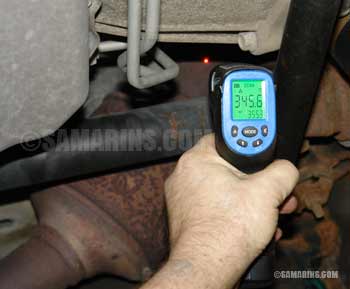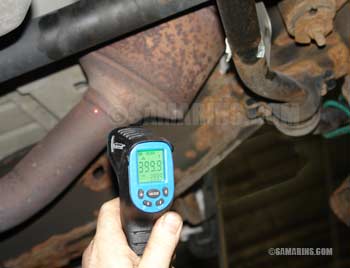Code P0420 Catalyst Efficiency Below Threshold (Bank 1)
October 08, 2022
The code P0420 - Catalyst Efficiency Below Threshold (Bank 1) means that there is a problem with the catalytic converter of the Bank 1. The code P0430 means the same fault for the Bank 2 catalytic converter in an engine with two cylinder banks (e.g., V6 or V8). The catalytic converter or "cat" is a key component of the vehicle emission control system.The code P0421 Warm Up Catalyst Efficiency Below Threshold means the same fault in case the primary (front) catalytic converter is designated as a "warm-up" three-way catalytic converter or WU-TWC (e.g. Mazda, Honda, Mitsubishi). In these cars, the code P0421 refers to the primary (front) monitored catalytic converter WU-TWC. The code P0431 is the same fault for WU-TWC of the Bank 2.
Symptoms:
With the codes P0420, P0421 or P0430 there could be no symptoms at all other than the Check Engine light, or you may notice some of the following signs:- Smell or unburned fuel from the exhaust like from an old car from the 50s.
- If the inner ceramic monolith of the catalytic converter has disintegrated, you may hear a rattling noise coming from the catalytic converter, like it has loose rocks inside.
- If the catalytic converter has burnt through, the exhaust may sound louder than usual.
- If something causes the catalytic converter to overheat, you may feel the excessive heat coming from the engine bay or the engine may produce clicking when it's shut down and cooling down.
Can you keep driving with P0420 code?
Only your mechanic can tell you this after at least an initial diagnosis. In some cars, pieces of the broken ceramic monolith from the catalytic converter can get sucked in back into the cylinders and scratch the cylinder walls, further damaging the engine.That said, over the years we met several motorists who continued driving with the code P0420/P0430 because their mostly high-mileage vehicles had no driveability issues other than the Check Engine light, and there was no other damage. Their explanation was along the lines that the car isn't worth much anyway, so there is no point in putting money into it.
Our advice, have your car checked and discuss your options with the mechanic or service adviser.
How the codes P0420, P0421 or P0430 are diagnosed:
The first step is to check for service bulletins, as there are cases where the car manufacturers recommend less expensive repairs instead of replacing catalytic converters. If you don't have access to the factory service manual, many bulletins are available online; search with Google for your vehicle's year, make and model bulletin P0420. We have also posted a list of websites that offer paid access to service manual of different cars at the bottom of this article: Check Engine Light: What to check first, repair options.For example, the service bulletin 01-010/16 for some Mazda vehicles recommends reprogramming the PCM as a solution for the code P0421 if the catalytic converter is confirmed OK following the testing procedure. The Acura service bulletin 19-049 also recommends updating the PGM-FI (SAE term: PCM) software for the code P0420 in the 2015-17 Acura TLX.
In another example, the Ford Service Bulletin 21-2381 for 2020-2021 Ford Expedition/Lincoln Navigator recommends de-sulfate catalytic converters by driving the vehicle in a certain pattern that includes acceleration and deceleration and driving between 50 mph and 65 mph.
Many car manufacturers also advise in their diagnostic procedures that if there are exhaust leaks near the catalytic converter, they must be repaired before testing the catalytic converter. There are several ways to test the catalytic converter, of course, follow the manufacturer's recommended procedure for your vehicle.
1. Clearing the code and checking if it comes back: To confirm a failed catalytic converter many car makers in their diagnostic procedure for this code suggest clearing the code and then after the engine is warmed up, driving the vehicle in a certain pattern (typically driving steady between 40 mph and 70 mph) for 10-20 minutes.
The next step is to check with the scan tool if the Catalytic Converter Readiness Monitor is set to COMPLETED and check if there are pending codes for the catalytic converter. If one of the above mentioned codes is present or pending, the catalytic converter is confirmed as bad and must be replaced. If no codes are present, no repair is required at this time.
For example, we had one 5-year old low-mileage Ford with the code P0420 that had been driven only for short trips. We cleared the code and drove the car on the highway in different modes and the code did not come back.
2. Comparing the signals from the pre-cat air/fuel ratio (Front O2) sensor to the post-cat rear O2 sensor. This test needs to be done with a scan tool after the catalytic converter is fully warmed up, with the engine running at a certain RPM range (typically1,500-2,000 RPMs) specified in the manufacturer's diagnostic procedure for these codes.
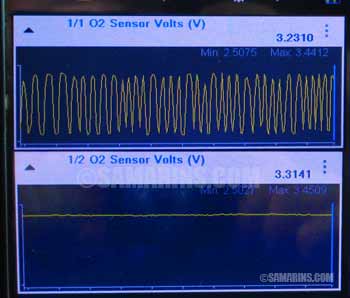 Good catalytic converter front (above) and rear O2 sensor (below) signal. Larger image.
Good catalytic converter front (above) and rear O2 sensor (below) signal. Larger image.If the catalytic converter is bad, you will see the rear O2 sensor signal repeat the signal of the front, pre-cat sensor. In other words, both signals will look similar, as in the lower photo.
This is because if the catalytic converter is bad, it just acts almost like a straight pipe and so the post-cat sensor shows almost the same signal as the pre-cat (front) sensor.
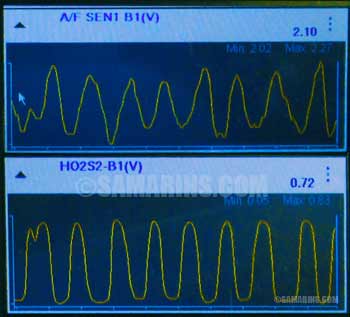 Bad catalytic converter front (above) and rear O2 sensor (below) signal. Larger image.
Bad catalytic converter front (above) and rear O2 sensor (below) signal. Larger image.The O2 signal voltage might be different in different cars, but the principal is the same: If the signal from the rear O2 sensor closely repeats the signal from the pre-cat sensor, like in the lower image, the catalytic converter has failed.
The photo above shows the signals of the front and rear O2 sensors in the Dodge Caravan with good catalytic converters. The photo below shows the A/F (front O2) and rear O2 sensor (HO2S2) signals in the Nissan Altima with the code P0420 coming on and off. This means the catalytic convertor is failing.
If it's a V6 or V8 vehicle with two banks and the catalytic converter has failed on one bank, it helps to compare both front and rear O2 sensor readings from both banks.
3. Checking the catalytic converter temperatures with the infrared thermometer. Mechanics often test if the catalytic converter is working with an infrared thermometer (aka. pyrometer).
Because the working catalytic converter burns off the unburned fuel or oil vapors coming out of the engine, the exhaust pipe temperature right after the catalytic converter should be higher than the temperature of the upstream exhaust pipe before the catalytic converter.
If the catalytic is burned through and acts like a straight pipe, the temperature of the downstream pipe will be lower, as the cat no longer burns off any unburned fuel. The upstream exhaust pipe temperature will be higher because it's closer to the engine.
To illustrate, we measured the exhaust temperatures before and after the front catalytic converter in the GMC Sierra (the engine is running at idle). It has a good working cat. The upstream exhaust pipe before the catalytic converter shows 345 degrees Fahrenheit (upper photo), while the downstream pipe coming out of the catalytic converter shows almost 400 degrees Fahrenheit, which means the catalytic converter does burn off unburned fuel.
Causes of the codes P0420, P0421, P0431 and P0430
- Failed catalytic converter
- The catalytic converter could be contaminated, e.g., due to high sulfur content in the fuel.
- Exhaust leak.
- Aging front air/fuel ratio (front O2) sensor, especially if the rear sensor is new.
- Incorrect PCM software that needs to be updated
What can cause a catalytic converter to fail sooner?
One common reason for catalytic converter failures is when the engine consumes oil, whether due to sticking oil rings, or scratched cylinder walls, or a faulty PCV system or a leaking turbocharger. Since the catalytic converter has to burn off the excess oil coming with the exhaust, it overheats and fails.If the engine misfires or one of the fuel injectors is leaking, the excess unburned fuel is also known to damage the catalytic converter.
Coolant leaking from the head gasket into the combustion chambers can also damage the catalytic converter.
Another reason is that when the air/fuel mixture becomes too lean, whether due to vacuum leaks or a bad mass airflow sensor, the catalytic converter also tends to fail sooner.
This means that if the catalytic converter has failed, the condition that caused it to fail must be diagnosed and repaired to prevent the new catalytic converter from failing again. We had cases where we ended up replacing the engine with a used unit and installing a new catalytic converter.
Basic Knowledge: How is the code P0420/P0430 set?
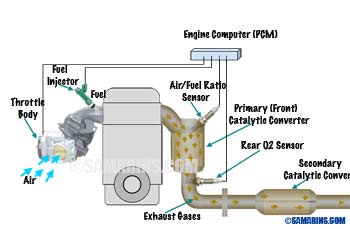 Catalytic converter exhaust emission control. Larger image.
Catalytic converter exhaust emission control. Larger image.